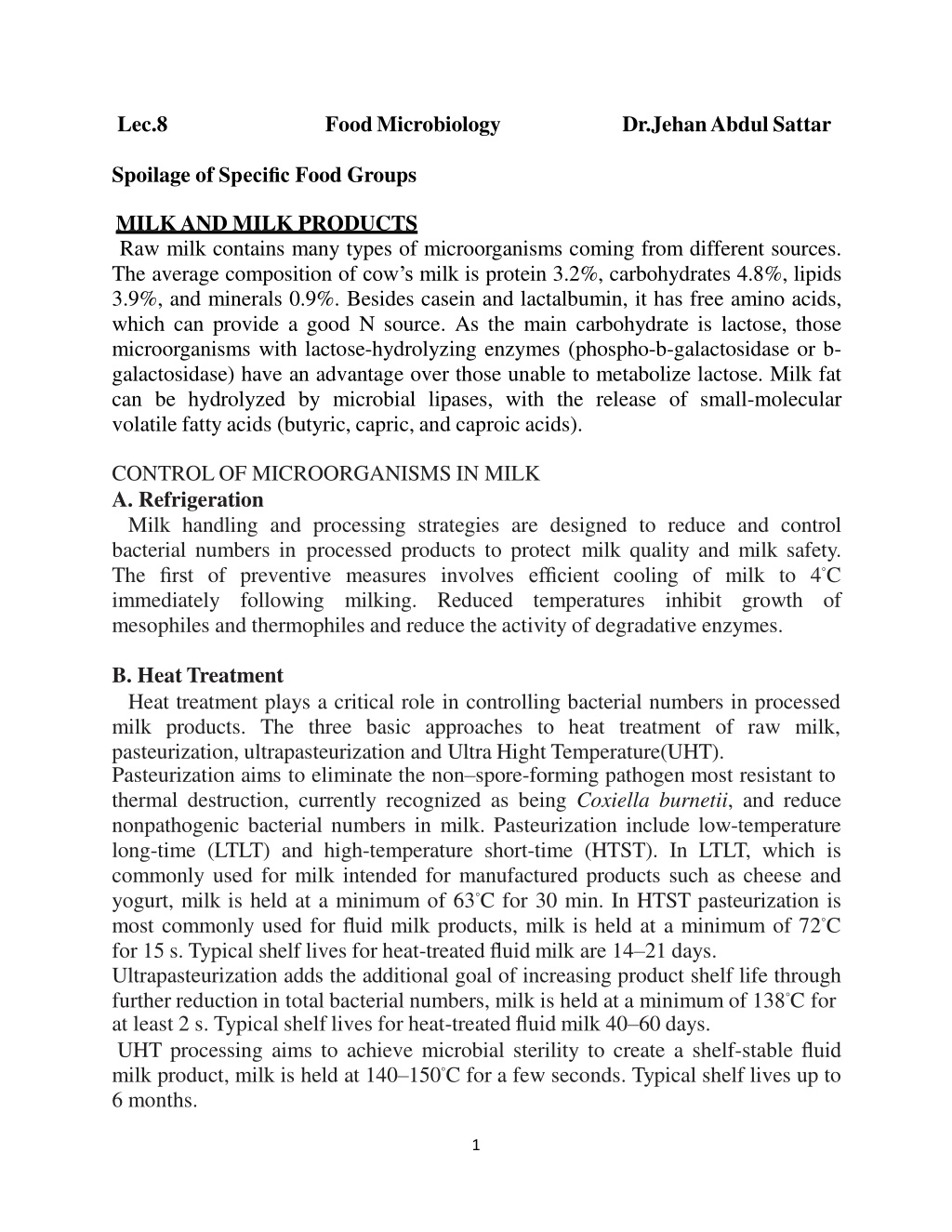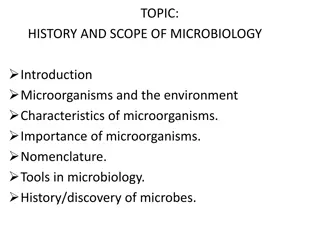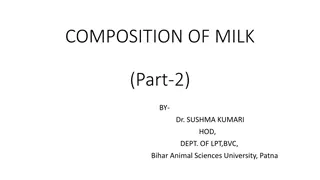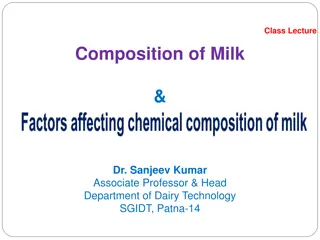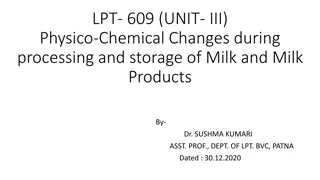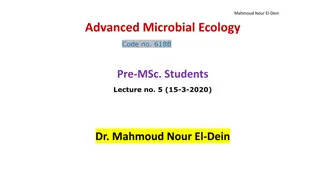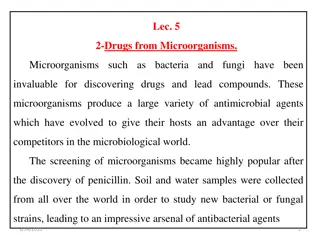Controlling Microorganisms in Milk for Quality and Safety
Raw milk contains various microorganisms, and efficient cooling to 4°C post-milking is essential. Heat treatment methods like pasteurization, ultrapasteurization, and UHT processing help control bacterial numbers. Techniques such as centrifugation, filtration, and additional methods like carbon dioxide addition and lactic acid cultures further aid in microbial control to enhance milk shelf life.
Download Presentation

Please find below an Image/Link to download the presentation.
The content on the website is provided AS IS for your information and personal use only. It may not be sold, licensed, or shared on other websites without obtaining consent from the author. Download presentation by click this link. If you encounter any issues during the download, it is possible that the publisher has removed the file from their server.
E N D
Presentation Transcript
Lec.8 FoodMicrobiology Dr.JehanAbdulSattar Spoilage of Specific Food Groups MILKAND MILK PRODUCTS Raw milk contains many types of microorganisms coming from different sources. The average composition of cow s milk is protein 3.2%, carbohydrates 4.8%, lipids 3.9%, and minerals 0.9%. Besides casein and lactalbumin, it has free amino acids, which can provide a good N source. As the main carbohydrate is lactose, those microorganisms with lactose-hydrolyzing enzymes (phospho-b-galactosidase or b- galactosidase) have an advantage over those unable to metabolize lactose. Milk fat can be hydrolyzed by microbial lipases, with the release of small-molecular volatile fatty acids (butyric, capric, and caproic acids). CONTROLOF MICROORGANISMS IN MILK A. Refrigeration Milk handling and processing strategies are designed to reduce and control bacterial numbers in processed products to protect milk quality and milk safety. The first of preventive measures involves efficient cooling of milk to 4 C immediately following milking. Reduced mesophiles and thermophiles and reduce the activity of degradative enzymes. temperatures inhibit growth of B. HeatTreatment Heat treatment plays a critical role in controlling bacterial numbers in processed milk products. The three basic approaches to heat treatment of raw milk, pasteurization, ultrapasteurization and Ultra Hight Temperature(UHT). Pasteurization aims to eliminate the non spore-forming pathogen most resistant to thermal destruction, currently recognized as being Coxiella burnetii, and reduce nonpathogenic bacterial numbers in milk. Pasteurization include low-temperature long-time (LTLT) and high-temperature short-time (HTST). In LTLT, which is commonly used for milk intended for manufactured products such as cheese and yogurt, milk is held at a minimum of 63 C for 30 min. In HTST pasteurization is most commonly used for fluid milk products, milk is held at a minimum of 72 C for 15 s. Typical shelf lives for heat-treated fluid milk are 14 21 days. Ultrapasteurization adds the additional goal of increasing product shelf life through further reduction in total bacterial numbers, milk is held at a minimum of 138 C for at least 2 s. Typical shelf lives for heat-treated fluid milk 40 60 days. UHT processing aims to achieve microbial sterility to create a shelf-stable fluid milk product, milk is held at 140 150 C for a few seconds. Typical shelf lives up to 6 months. 1
HTST and ultrapasteurized products require refrigeration at 4C or less during storage, UHT products can be stored at 25 C. C. Centrifugation Centrifugation of milk causes bacteria, dirt particles, somatic cells, animal hairs, and bacterial spores to migrate outward, whereas lighter fat globules and casein micelles migrate inward. Two techniques known as clarification and bactofugation. Clarification is primarily designed to remove dirt particles, somatic cells, and animal hairs, whereas bactofugation is specially designed to remove bacterial spores from milk. Using high-force centrifugation, the spore load of raw milk can be reduced by greater than 99%. D. Filtration Microfiltration and ultrafiltration utilize the larger relative size of bacterial cells to separate out microbial contaminants. Filters with very small pores allow milk components to pass through while blocking bacteria, thus separating contaminants. Typically rated in terms of pore diameter, microfiltration filters range from 0.2 to 5.0 m. Using microfiltration, lactose, minerals, and small proteins pass through into the permeate, whereas fat, very retained.Ultrafiltration filters range from 103to105D. Using ultrafiltration, minerals and lactose pass through into the permeate, whereas proteins, fats, and bacteria are retained . Although filtration can not remove all microorganisms, it can achieve a 99.99% reduction of the total bacterial count and a 99.95% reduction in the total spore count .Milk with higher fat percentages causes membrane fouling, making this technique most useful for treating skim milk. large proteins, and bacteria are E.Additional Microbial Control Methods Several less commonly utilized techniques exist for controlling microbial growth in milk. Addition of carbon dioxide to milk at 10 30 mm/L inhibits growth of the common spoilage organism P. fluorescens . This technique has been reported to extend the shelf life of refrigerated milk by several days. The use of the natural antibiotic nisin to inhibit gram-positive bacterial growth in milk. Addition of lactic acid starter cultures to raw milk has been shown to inhibit growth psychrotrophs. Although the lactic acid bacteria do not multiply at refrigeration temperatures, their metabolism results in a pH decrease to below 6 and possible organoleptic changes. of 2
MICROBIOLOGYOF MILKAND MILK PRODUCTS A. Raw Milk Microbial spoilage of raw milk can occur from the metabolism of lactose, proteinaceous compounds, fatty acids and the hydrolysis of triglycerides. If the milk is refrigerated immediately following milking and stored for days, the spoilage will be predominantly caused by Gram-negative psychrotrophic rods, such as Pseudomonas,Alcaligenes,Flavobacterium spp., and some coliforms. Pseudomonas and related species, proteinaceous compounds to change the normal flavor of milk to bitter, fruity, or unclean.They also produce heat-stable lipases (producing rancid flavor). The growth of lactose-positive coliforms produces lactic acid, acetic acid, formic acid, CO2, and H (by mixed-acid fermentation) and causes curdling, foaming, and souring of milk. Some Alcaligenes spp. and coliforms can also cause ropiness (sliminess) by producing viscous exopolysaccharides. However, if the raw milk is not refrigerated soon, growth of mesophiles, such as species of Lactococcus, Lactobacillus, Enterococcus, Micrococcus, Bacillus, Clostridium, and coliforms, along with Pseudomonas, Proteus, and others, predominates. But lactose- hydrolyzing species, such as Lactococcus spp. and Lactobacillus spp., generally predominate, producing enough acid to lower the pH growth of others. Yeast and mold growth, under normal conditions, is generally not expected. being lactose negative, metabolize and prevent or reduce B. PasteurizedMilk Raw milk is pasteurized before it is sold for consumption as liquid milk. Thermoduric bacteria (Micrococcus, Streptococcus, Corynebacterium, and spores of Bacillus and Clostridium) survive the process. In addition, coliforms, Pseudomonas, Alcaligenes, Flavobacterium, and similar types can enter as postpasteurization contaminants. Pasteurized milk, under refrigerated storage, has alimited shelf life, mainly due to growth of these psychrotrophic contaminants. some Lactobacillus, Enterococcus, C. Concentrated Liquid Products Evaporated milk, condensed milk, and sweetened condensed milk are the principal types of concentrated dairy products susceptible to limited microbial spoilage during storage. All these products are subjected to sufficient heat treatments to kill vegetative microorganisms as well as spores of molds and some bacteria. Evaporated milk is condensed whole milk with 7.5% milk fat and 25% total solids. It is packaged in hermetically sealed cans and heated to obtain commercial sterility. Under proper processing conditions, only thermophilic spores of spoilage bacteria can survive, and exposure to high storage temperature (43C or 3
higher) can trigger their germination and subsequent growth. Under such conditions, Bacillus species, such as B. coagulans, can cause coagulation of milk (flakes, clots, or a solid curd). Condensed milk is generally condensed whole milk and has 10 to 12% fat and 36% total solids. The milk is initially given a low-heat treatment, close to pasteurization temperature, and then subjected to evaporation under partial vacuum (at 50C). Thus, it can have thermoduric microorganisms that subsequently can grow and cause spoilage. Other microorganisms can also get into the product during the condensing process. Sweetened condensed milk contains 8.5% fat, 28% total solids, and 42% sucrose. The whole milk is initially heated to a high temperature (80 to 100C) and then condensed at 60C under vacuum and put into containers. Because of a low aw, it is susceptible to spoilage from the growth of osmophilic yeasts , causing gas formation. If the containers have enough headspace and oxygen, molds (e.g., Penicillium and Aspergillus) can grow on the surface. D. Flavored Milks The microbiology of flavored milk differs from that of unflavored milk in that conventionally pasteurized chocolate conventionally pasteurized unflavored milk. After 14 days at 6 C, chocolate milk samples had higher standard plate counts and higher psychrotrophic plate counts than unflavored milk samples from the same raw milk. The chocolate powder, and not the additional sucrose, contributed to the increased bacterial growth. The chocolate powder did not introduce additional microbes into the milk. Rather microbes already present in the raw milk grew faster in the presence of the chocolate powder. milk typically spoils faster than E. Butter Butter contains 80% milk fat and can be salted or unsalted. The microbiological quality of butter depends on the quality of cream and the sanitary conditions used in the processing. Growth of bacteria (Pseudomonas spp.), yeasts (Candida spp.), and molds (Geotrichum candidum) on the surface causes flavor defects (putrid, rancid, or fishy) and surface discoloration. In unsalted butter, coliforms, Enterococcus, and Pseudomonas can grow and produce flavor defects. MEAT PRODUCTS A. Raw Meat Meats are the most perishable of all important foods. Meats contain a large quantity of all nutrients required for the growth of bacteria, yeasts, and molds. 4
Fresh meats from food animals and birds contain a large group of potential spoilage bacteria that include species of Pseudomonas, Acinetobacter, Moraxella, Shewanella, Alcaligenes, Aeromonas, Escherichia, Enterobacter, Serratia, Hafnia, Proteus, Brochothrix, Micrococcus, Enterococcus, Lactobacillus, Leuconostoc, Carnobacterium, and Clostridium, as well as yeasts and molds. The predominant spoilage flora in a meat is determined by nutrient availability, oxygen availability, storage temperature, pH, storage time of the product, and generation time of the microorganisms present in a given environment. To delay microbial spoilage, fresh meats are stored at refrigerated temperature. Thus, normally psychrotrophic bacteria are the most predominant types in raw meat spoilage. Under aerobic storage at low temperature, growth of psychrotrophic aerobes and facultative anaerobes is favored. In retail-cut meats, because of a shorter generation time, Pseudomonas spp. grows rapidly, using glucose first and then amino acids; the metabolism of amino acids is accompanied by the production of malodorous methyl sulfides, esters, and acids. In meats with high pH or low glucose content, or both, Acinetobacter and Morexella, which metabolize amino acids instead of glucose, can grow rapidly and produce undesirable odors. Spoilage by these strict aerobes in the form of off odor and slime. Along with offensive odors, some strains also produce H2S in small amounts to cause greening of the meat (H2S oxidizes myoglobin to a form of met myoglobin, causing a green discoloration). Facultative anaerobic Enterobacter, Serratia, Proteus, and Hafnia species metabolize amino acids while growing in meat to produce amines, ammonia, methylsulfides, and mercaptans, and cause putrefaction. Because amines and ammonia are produced, the pH of the meat usually changes to alkaline range, and meat can have a pinkish to red color. Yeasts may grow under aerobic conditions on the meats and causes sliminess, lipolysis, off odors and tastes, discolorations (white, cream, pink or brown, due to pigments in yeasts). Aerobic growth of molds may cause the following: 1 Stickiness:Growth of molds makes the surface of the meat sticky. 2 Discoloration :Black spot: Usually caused by Cladosporium . White spot: Caused by Geotrichum. Green patches: Caused by Penicillium spp. 3- Decomposition of Fats: Many molds have lipases an cause hydrolysis of fats. Molds also help in the oxidation of fats. 4-Off odor and off tastes: Molds give a musty flavor to meat. To reduce spoilage of fresh meats, initial microbial level should be reduced. In addition, storage at low temperatures (close to 0 to 1C), modified atmosphere packaging, and vacuum packaging should be done. Several other methods to 5
reduce initial microbial load and slow growth rate of Gram-negative rods are being either used or tested. These include the addition of small amounts of organic acids to lower the pH of meat (slightly above pH 5.0), drying of meat surfaces (to reduce aw), and a combination of the factors given , including lower storage temperature. B. Processed Meat Products This group includes high-heat-processed and low-heat-processed uncured and cured meat products. High-heat-processed cured and uncured meats are given heat treatment to make them commercially sterile. Thus, they may only have some thermophilic spores surviving, which will not germinate unless the products are temperature abused. Low-heat-processed uncured meats, such as roasts, are given heat treatment at an internal temperature of (60 to 71C). Generally, the surface of the meats (and thus most of the microorganisms) is exposed to the final temperature for 1 h or more, depending on the size of the meat. Under this condition, only the spores of Bacillus and Clostridium spp. and some thermoduric vegetative species (some Enterococcus, Micrococcus, Lactobacillus inside the product) can survive. Many types of microorganisms can enter as post heat contaminants into the products from equipment, personnel, water, and air. In some situations, spices and other ingredients are added to the products after heating, which, in turn, can be the source of microbial contamination of the products. Some products are sliced before vacuum packaging, which increases the chances of contamination on the surface area of the product from the equipment and environment. Psychrotrophic facultative anaerobic and anaerobic bacteria have been implicated in the spoilage of these products. Poultry meat Poultry meat like meat of other animals is also susceptible to contamination by various sources. Contamination of skin and lining of the body cavity take place during various processing operations. The organisms of great importance in poultry are Salmonella spp. and Campylobacter psychrotropic bacteria Pseudomonas, Acenitobacter and Flavobacterium have also been isolated from poultry carasses. It is important to freeze the poultry fast in order to keep it in good condition for several months. Freezing further reduces the number of microorganisms in the poultry meat provided the temperature is maintained quite low (-18 C or below). jejuni. Several Gram negative 6
Fish spoilage: Fish is a very perishable, with water 65 80 %, high-protein food (14 20) % that typically contains a high level of free amino acids. The lipid content of the fish is up to 25%, it has very low content of connective tissue, i.e. approximately 3% of the total weight as compared with around 15% in meat. Non-fatty fish, the fat levels are only about 0.5%, while in fatty fish, levels can vary between 3 and 25%. Microbes metabolize these amino acids, producing ammonia, biogenic amines such as putrescine, histamine, and cadaverine, organic acids, ketones, and sulfur compounds. Degradation of lipids in fatty fish produces rancid odors. In addition, marine fish and some freshwater fish contain trimethylamine oxide that is degraded by several spoilage bacteria to trimethylamine (TMA), the compound responsible for fishy off odors. Iron is a limiting nutrient in fish, and this favors growth of bacteria such as Pseudomonas that produce siderophores that bind iron. Spoilage bacteria differ somewhat for freshwater and marine fish and for temperate and tropical water fish. Storage and processing conditions also affect microbial growth. Pseudomonas and Shewanella are the predominant species on chilled fresh fish under aerobic conditions. Packing under carbon dioxide and addition of low concentrations of sodium chloride favor growth of lactic acid bacteria and Photobacterium phosphoreum. Heavily wet-salted fish support growth of yeasts while dried and salted fish are spoiled by molds. Pasteurization kills vegetative bacteria but spores of Clostridium and Bacillus survive and may grow, particularly in unsalted fish. Spoilage of fish and sea foods: Halophilic bacteria like Serratia, Micrococcus, Bacillus, Alcaligenes and Pseudomonas cause spoilage of salt fish. Shell fish are spoiled by Acinetobacter, Moraxella and Vibrio. Crab meat is spoiled by Pseudomonas, Acinetobacter and Moraxella at low temperature and by Proteus at high temperature. Microbial loads in shrimps, oysters, and clams depend on the quality of the water from which they are harvested. During handling, fecal coliforms, fecal streptococci, and may be S. aureus incorporated into the product. Salmonella also is found in oysters possibly due to contaminated water. Seafood also is the source for Pseudomonas spp., C. perfringens, L. monocytogenes, Vibrio parahemolyticus, 7
Salmonella enterica serovar enteritidis and typhimurium, Campylobacter jejuni, Yersinia enterocolitica, and Enteroviruses (Hepatitis A). Smoked salmon and shrimps also are found to carry pathogenic L. monocytogenes. Eggs: The hen s egg is an excellent example of a product that normally is well protected by its intrinsic parameters. Externally, a fresh egg has three structures, each effective to some degree in retarding the entry of microorganisms: the outer waxy shell membrane; the shell; and the inner shell membrane. Internally, lysozyme is present in egg white. This enzyme is quite effective against Gram- positive bacteria. Egg white also contains avidin, which forms a complex with biotin, that making this vitamin unavailable to microorganisms. In addition, egg white has a high pH (about 9.3) and contains conalbumin, which forms a complex with iron, thus rendering it unavailable to microorganisms. On the other hand, the nutrient content of the yolk material and its pH in fresh eggs (about 6.8) make it an excellent source of growth for most microorganisms. Freshly laid eggs are generally sterile. However, in a relatively short period of time after laying, numerous microorganisms may be found on the outside and, under the proper conditions, may enter eggs, grow, and cause spoilage. The speed at which microbes enter eggs is related to temperature of storage, age of eggs, and level of contamination. The use of CO2 to effect the rapid cooling of eggs led to fewer bacteria in the interior compared to conventional cooling. The bacteria found in eggs were Pseudomonas, Acinetobacter, Proteus, Micrococcus, Salmonella, Staphylococcus. Among the molds generally found are members of the genera Mucor, Penicillium, Cladosporium, and others; Torula is the only yeast found in eggs. The most common form of bacterial spoilage of eggs is a condition known as rotting. Green rots are caused by Pseudomonas spp., especially fluorescens; colorless rots by Pseudomonas, Acinetobacter, and other species; black rots by Proteus, Pseudomonas, and Aeromonas; pink rots by Pseudomonas; red rots by Serratia spp., and custard rots by Proteus vulgaris and P. intermedium. members of the following genera: Aeromonas, Alcaligenes, Escherichia, Enterobacter, Flavobacterium, Serratia, and 8
Bacteria also cause a condition in eggs known as mustiness. Ex:Pseudomonas graveolens and Proteus spp. Mold spoilage of eggs is generally referred to as pinspots, from the appearance of mycelial growth on the inside upon candling. Penicillium spp. and Cladosporium spp. are among the most common causes of pinspots and fungal rotting in eggs. The entry of microorganisms into whole eggs is favored by high humidity. More bacteria are found in egg yolk than in egg white, and the reason for a general lack of microorganisms in egg white is quite possibly its content of antimicrobial substances. In addition, upon storage, the thick white loses water to the yolk, resulting in a thinning of yolk and a shrinking of the thick white. This phenomenon makes it possible for the yolk to come into direct contact with the inner membrane, where it may be infected directly by microorganisms. Once inside the yolk, bacteria grow in this nutritious medium, producing by products of protein and amino acid metabolism such as H2S and other foul-smelling compounds. The effect of significant growth is to cause the yolk to become runny and discolored. In regards to the destruction of salmonellae in boiled shell eggs, it is generally recognized that cooking until the entire yolk is solidified is sufficient to destroy S. enterica serotype Enteritidis. 9
